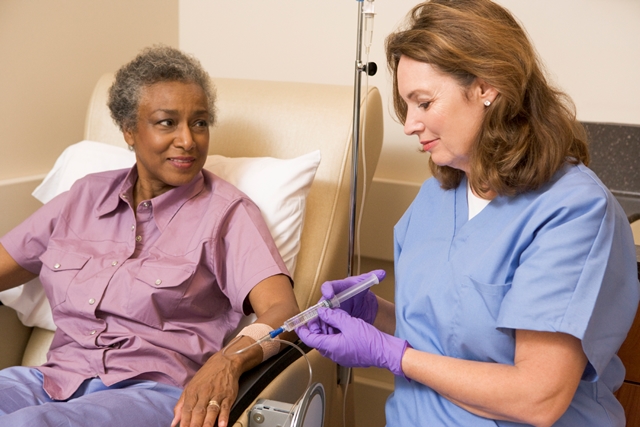A cancer diagnosis is scary. What follows, though, can easily be just as daunting: everything conjured by the word “chemotherapy.”
In the treatment, chemicals are used to destroy cancer cells or slow their growth. The drugs can harm healthy cells as well, though, which can cause side effects.
“When patients first come to us, it’s common for them to be terrified,” said Abbie Ochsner, an assistant nurse manager with St. Elizabeth Healthcare’s Cancer Care Center in Edgewood. “They might have a general idea what ‘chemo’ is, but they have a million questions and as many worries. It’s intimidating.”
That, she adds, is mainly because of misperceptions of the side effects.
“A lot of times, they come in expecting that they or their loved one will spend hours in treatment, throwing up and being sick because that’s how it’s been portrayed in the movies. It’s just not that way. It hasn’t been for a long time,” Ochsner said. “Chemotherapy is just so much different than it was even 10 years ago. There are so many more drugs and they’re more targeted. They’re not as toxic as they once were. It’s not like in the movies.”
Information is a patient’s best weapon. At the Edgewood Center, patients are walked through what to expect before treatment starts. They’re also encouraged to ask any questions that may have.
“The more they know, the better they do,” Ochsner said.
Five important things to know about chemo:
- It is often only part of your treatment. Chemo is more often than not used in conjunction with other treatments, such as radiation therapy or biological therapy. Chemotherapy is also sometimes used to shrink tumors or keep them in check until they can be removed surgically.
- With hundreds of highly targeted chemotherapy drugs, the kind used for your treatment depends on the kind of cancer you have. Other health problems you may have are also considered. There are many options you and your doctor have.
- If at first you don’t succeed “ If your first chemotherapy drug isn’t working, your doctor can try another. And another. Chemotherapy is often delivered in cycles “” a period of treatment followed by brief respites to see how successful the treatment is being. If your doctor isn’t satisfied with your progress, it’s easy to take a different tack on your care.
- Delivery methods differ. Your chemotherapy may be delivered intravenously, which is the traditional method, but it can also be administered by injection via a single shot, topically with a cream rubbed onto your skin or even orally with a pill or liquid prescribed by your doctor.
- Side effects vary. Nausea was once the hallmark of chemo, but is less prevalent these days because of better drugs. Fatigue or restlessness are also common, but your doctor with work with you to minimize these effects. Many patients can continue to live their lives normally during treatment, even working a normal schedule.
For more information, visit St. Elizabeth’s Cancer Care Center.

